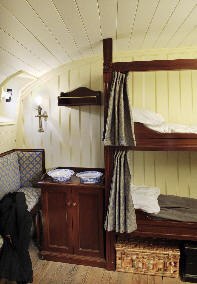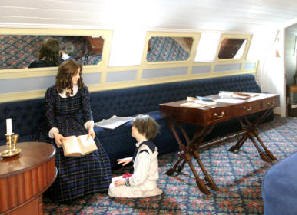So in the company of Mike C, on a rare appearance in the UK, I set off for St Ives. My second boat, Llamedos, was kept upriver at Huntingdon for 5 years (1978-82?) so I fancied a drive round some of the old haunts.
First thing that has definitely improved is the journey. The road to Huntingdon being at least half hour less than 30 years back.
St Ives seemed much bigger and busier than I recall with a proper supermarket and all. After collecting the Satellite Dish we went into St Ives centre. The Town Square was chockers with cars but we got a spot eventually and wandered down by the river where there is a beautiful bridge. I remembered an excellent pub "The Oliver Cromwell" from days gone by and it's still excellent with no noxious music, barmaids to die for, a good range of beers (sodding car!) and a fish pie most scoffworthy. The entertainment was provided by the local swans who having harrassed the traffic on the bridge then sauntered down to the pub for a gander or whatever the swan equivalent of a gander is.A swander perhaps.........

 |
| The Bad 'Ole Baste |
 |
| The Oliver Cromwell |
 |
| Mike C leaves and barmaid looks longingly through window |
 |
| St Ives Bridge |
 |
| Looking north from the bridge |
 |
| Houghton Mill |
After that to Houghton Mill, The Hemingfords, Huntingdon itself where amazingly the house and boatyard still remain in a state of disrepair, Offord Cluny (where the pub is the Swan-should be the George (gettit?) and St Neots. Good times remembered and a pleasant day out. Oh and what a tv picture. A major success. Just got to wait a couple of years for a decent programme.....
More deer (deerer?) await at Ashridge the following day. Might be muntjac, might be Chinese deer-I dunno never did O level Deer but got very close to what I thought was half a dozen and was getting closer when a bunch of yellow hazard jacketed people came tramping through the woods and scared the wotsit out of them. They took off at a hell of a lick and suddenly there was a herd of about 30 to 40 who had been there all along. They'd probably been watching me all the time thinking this noisy sod thinks we don't know he's there.
Anyway too far away and too slow to get a decent photo so here's my best efforts. According to the wonder that is Wikpedia the muntjac is the oldest deer at between 15 and 30 million years old. Amazing that they could move so fast.
Wednesday and off to Bristol to pick up Ollie who is home for a couple of days before starting his new job in France. I have combined this small removal job with a trip to Chewton Mendip in Somerset where I have stayed at the excellent Copper Beeches many times before and yet am allowed back. I am joined by Adrian for the trip and we are meeting Peter B who is travelling up from Exeter. Apart from being a very good B & B Copper Beeches is also a 2 minute walk from the Waldegrave Arms-as fine a pub as you'll encounter. We three met there at lunchtime and after a light lunch headed into Wells, the smallest city in the country and deserving of a longer visit. A future venue for a cultural visit no doubt.
In the evening after Ady had his afternoon nap we adjourned to the pub where we allowed ourselves a third pint to accompany dinner. I started with smoked salmon and finished with homemade faggots. Very balanced.
Thursday and off to Bristol. We aren't due to pick up Ollie till after 3pm so a trip to SS Great Britain is planned. I've been before with Pam and Joseph but still enjoyed the experience-there is a lot to learn.
And here's your chance......skip it if you're bored....
The wrought iron steamship was built in 1843 in Bristol, under the supervision of Brunel for the Great Western Steamship Company. The Great Britain set the design standards for today’s modern shipping and eminently demonstrated the industry and inventiveness of the Victorian era. Almost single-handedly Brunel shaped the future of mass passenger travel and international communications.
 Whilst her first few voyages demonstrated her technological ability,
they were not a great financial success, attracting far fewer passengers
than anticipated. Her career in this trade was thus short lived, and
after she ran aground on the sands of Dundrum Bay in Northern Ireland in
1846, her engines were so badly damaged that she was sold on.
Whilst her first few voyages demonstrated her technological ability,
they were not a great financial success, attracting far fewer passengers
than anticipated. Her career in this trade was thus short lived, and
after she ran aground on the sands of Dundrum Bay in Northern Ireland in
1846, her engines were so badly damaged that she was sold on.Under Gibbs Bright and Co, the ship prospered. The new owners took advantage of the increase in emigration caused by the Australian gold rush, and re-built the ship as an emigrant carrier, taking people to Australia. With a new upper deck added and a new engine fitted, she could now transport 750 passengers in three classes.



 Over the next 24 years and 32 voyages she carried over 16,000
emigrants to Australia, and was known in her time as one of the fastest,
most elegant and luxurious emigrant clipper ships – the ‘Greyhound of
the seas’.
Over the next 24 years and 32 voyages she carried over 16,000
emigrants to Australia, and was known in her time as one of the fastest,
most elegant and luxurious emigrant clipper ships – the ‘Greyhound of
the seas’.The average time she took on the return journey to Australia was 120 days - very competitive for the mid-19th century. Passage on the ss Great Britain could virtually guarantee that a passenger would arrive on time, well ahead of any sail powered rivals.
As meat went off easily on these long voyages, large numbers of live animals were carried for food, giving the ship the appearance of Noah's Ark rather than an emigrant ship. On one voyage in 1859, the ship carried 133 live sheep, 38 pigs, 2 bullocks, 1 cow, 420 fowl, 300 ducks, 400 geese and 30 turkeys. Passenger diaries record the ship as smelling and sounding like a barnyard!
Between 1854 and 1855 she was chartered by the Government to carry troops to and from the Crimean War, and over the course of the conflict transported over 44,000 troops.
Following the war she was rebuilt yet again before being chartered by the Government for further troop transportation duties, carrying the 17th Lancers and 8th Hussars to the Indian Mutiny.
In 1861, for a marginally less serious conflict, the Great Britain also carried the first ever English cricket side to tour Australia. The tour was immensely successful with a 15,000 crowd attending the opening match at Melbourne. The tourists played 12 games in all, winning 6, drawing 4 and losing 2.
And bad news could often follow glad news, such as when the onboard newspaper the ‘Great Britain Times’ reported death of the pet koala bear belonging to the ship’s carpenter. Apparently the marsupial died of ‘pulmonary consumption’ on 25 October 1865, much to the sadness of crew and passengers.
One of the ship’s more eccentric captains, Captain Gray, climbed each mast at least once a week and interrupted one voyage to Australia to claim the uninhabited island of St. Martin for the Empire. He held a banquet that evening to celebrate.


Photographs courtesy of the ss Great Britain Trust and some bald bloke with a camera thingy
In all the Great Britain had 25 accidents entered in her logs – ranging from collisions with other vessels, running aground, lost spars and mast damage, to losing that eccentric Captain Gray in mysterious circumstances.
 She remained in Port Stanley through the First World War, with coal from her hold helping to replenish the battle cruisers Inflexible and Invincible
before the decisive battle of the Falkland Islands on 7 December 1914,
in which the armoured cruisers Gneisenau and Scharnhorst and light
cruisers Nurnberg and Leipzig were sunk.
She remained in Port Stanley through the First World War, with coal from her hold helping to replenish the battle cruisers Inflexible and Invincible
before the decisive battle of the Falkland Islands on 7 December 1914,
in which the armoured cruisers Gneisenau and Scharnhorst and light
cruisers Nurnberg and Leipzig were sunk.By 1937 the Great Britain’s hull was no longer watertight, and after being towed a short distance from Port Stanley, she was beached and abandoned to the elements.
Attempts to rescue her in the late 1930’s and 1960’s failed, but finally in 1970 an epic salvage effort refloated the ship, and she was towed back home across the Atlantic to Bristol.

 Despite spending nearly 100 years suffering in the harsh South
Atlantic weather, the Great Britain was able to float up the River Avon
herself! After covering over a million miles, Brunel’s 155 year old iron
hull had stood the test of time superbly.
Despite spending nearly 100 years suffering in the harsh South
Atlantic weather, the Great Britain was able to float up the River Avon
herself! After covering over a million miles, Brunel’s 155 year old iron
hull had stood the test of time superbly.Following yet another refit, this time costing in the region of £11.3 million, Brunel’s ss Great Britain was re-launched as one of the world’s most important maritime museums in 2005. For further details visit www.ssgreatbritain.org.
.........................I'll be asking questions later

Afterwards in order to kill some time Peter insisted on going to a pub he knew, the Rose of Denmark, where I had one of the best and most imaginative Ploughman's ever-Salami Milano, Smoked trout and French Goat's Cheese. Most pleasant. Afterwhich we bade farewell to Peter.
To Ollie's where his highly trained team soon loaded the car with an enthusiasm that suggested a gladness to see the back of him. Nice to see Nat and Jo cheering as we reversed at high speed down Lancaster Road doing the statutory wheely whilst the neighbours pelted us with fruit and sped off for downtown Berkhamsted. Home by 8 via a tincture at the Lamb and dived headlong into Pam's excellent Cottage Pie.Job done.
A Footnote to the last posting. Avid readers will recall the last post was about my visit to Norfolk to commemorate 40 years since buying Broad Wave for 850 quid from the defunct Clifford E Allen yard at Coltishall. Adrian has done further research since our trip and has found the following link ;
http://www.broadlandyachtbrokers.co.uk/used-boats/used/7/
which shows a splendidly refurbished Broad Wave 40 years later up for sale at 24k plus. I think another trip is called for. Such fun.
But before then we have the Feast of Christmas. First Sunday of Advent tomorrow followed by Cowroast Boaters' Gathering next Saturday. So much to do and so little time.......until then, a bientot













No comments:
Post a Comment